目前在vue 2.5.9测试学习
顺便推荐调试工具:vue-devtools,直接去chrome商城安装即可。在引入vue.js时,不能使用min版本不然无法使用。
var vm=new Vue({
name:'root', //给这里实例化对象取一个名字,组件想知道是哪个实力化对象调用的就使用this.$parent.$options.name
el:'#app’, //不能将容器设置在html和body标签上,如果el没声明也可以使用 vm.$mount('#app')来实现
parent:baba, //该属性一般用在new Vue对象中,
data:{ //存放数据
str:'字符串数据',
arr:[ //json数据
{name:'名字',age:123},
{name:'名字',age:123},
],
obj:{age:22,name:'小么'}
},
methods:{ //存放事件
click:function(e){
console.log(this);
}
},
components:{},
render:...,
directives:...,
filters:...,
computed:{
myname:{
get(){ return this.xx },
set(newValue){ this.$refs.xxx.src = newValue } //在别的地方修改 this.myname = 'baidu.con',newValue就能获取到值
}
},
watch:{ //监听的数据有变为就触发回调
//遇到复合型数据推荐结构是[{},{}]
str:function(new_value,old_value){
},
arr:{
handler: function (val, oldVal) { /* ... */ }, //不要使用箭头函数,否则this无法指向vue对象
deep: true //遇到对象或者复合结构要开启深度监听,简单数组不需要开启
},
'obj.age':function (val, oldVal) { /* ... */ },
obj:[
function handle1 (val, oldVal) { /* ... */ },
function handle2 (val, oldVal) { /* ... */ }
]
},
//生命周期
beforeCreate:function(){
//vue实例化前执行,data数据和dom还没有数据
},
created:function(){
//vue实例化后执行,已经有data数据,但还没加载dom
},
beforeMount:function(){
//组件内容渲染到页面前执行,data数据有了,dom还没在页面中
},
render:function(){
//render执行顺序是在beforeMount和mounted之间,它的作用就是把DOM插入到页面上,所以到了mounted执行时我们才能看见数据
},
mounted:function(){
//组件内容渲染到页面后执行,data和dom都在页面中了
},
beforeUpdate:function(){
//只有当data数据发生变化后,但数据还没插入到dom的时候执行
},
updated:function(){
//data数据变化完成并插入到dom之后执行
},
beforeDestroy:function(){
//销毁之前回调,使用vm.$destroy()即是销毁了vm组件且先触发beforeDestroy之后是触发destroyed
},
destroyed:function(){
//销毁后回调,这里的销毁后数据还是存在的,只是修改数据已经无法驱动修改视图变化了而已,
//之前绑定在dom的事件例如click mouseenter等等还是有效的,仅仅是无法驱动视图变化而已,之前有的还是有
},
//activated和deactivated,只针对开启keep-alive的组件触发
activated:function(){
console.log("进页面")
},
deactivated:function(){
console.log("离开页面")
},
//组件生命周期
beforeRouteEnter(to, from, next) {
//不能获取到this
// do someting
// 在渲染该组件的对应路由被 confirm 前调用
},
beforeRouteUpdate(to, from, next) {
// do someting
// 在当前路由改变,但是依然渲染该组件是调用
},
beforeRouteLeave(to, from ,next) {
//能获取到this
// do someting
// 导航离开该组件的对应路由时被调用
next()
}
});
vue对象嵌套、加载顺序问题
对于新手或者是要投入项目的最好先搞清楚,方便之后的架构设计
1,情况:父对象id=xx,里面嵌套着子对象xx1,并且里面有相同元素{{a}}
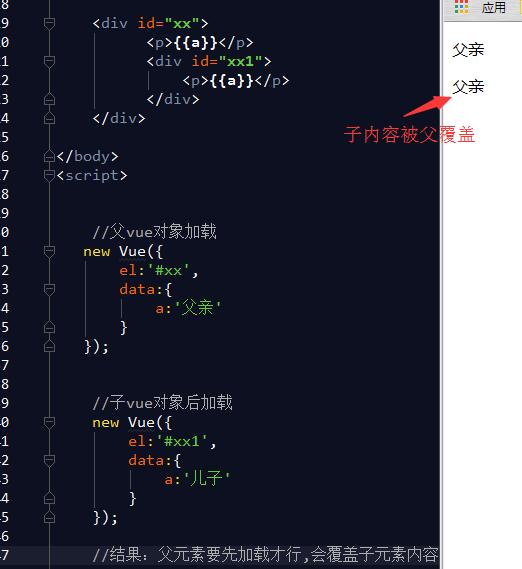
修改后
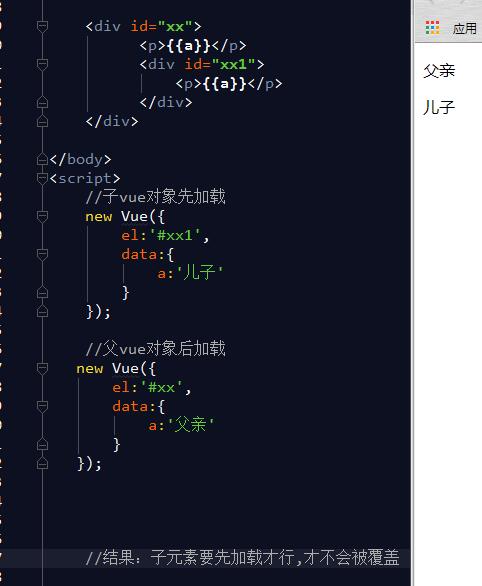
2,情况2:父元素里面嵌套着子元素,但子元素里面的{{a1}},父元素没有

修改后
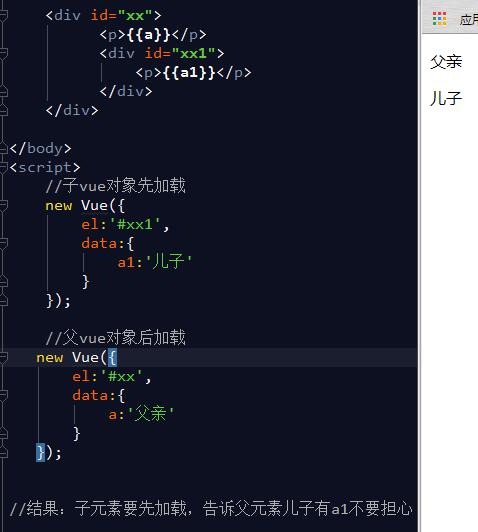
总结:
1,子元素有的属性,父元素一定要有;父元素有的属性,子元素可以不声明。
2,子元素要加载在父元素前面
//放在公共样式的最最前面
[v-cloak] {
display: none !important;
}
<div id=“app” v-cloak> </div>
vue数据的增、删、改
vue不允许添加额外属性,只能在已有的基础上修改,我们可以自定义一个空对象,在其基础上添加属性也能达到这样的效果。
var vm1= new Vue({
el: '#repeat',
data:{
str:'', //预留空的
obj:{} //预留空的
obj1:{a:''} //如果模板中要调用obj1.a,就要在vue实例中预先设置好,否则会报错。
}
})
在修改数组、对象时也需要vue内置的方法去修改,如果还想有数据双向绑定效果就要用以下方法去修改。否则修改后的视图也不会改变。
对象
修改: Vue.set(vm1.obj,'age',123) //添加了age属性 this.$set(this.someObject,'b',2) //临时补加a属性且赋值,如果要删除使用this.$delete(this.someObject,'b') 或 vm1.str=xxxx //直接修改
添加:
this.obj = Object.assign({}, this.obj, { a: 1, b: 2 }); //在obj对象上添加了a属性和b属性
调用:{{obj.age}}
数组
data:{
arr:['我的名字','是谢尔顿']
}
修改:
Vue.set(this.arr, 1, '陈陈')
修改长度
example1.items.splice(newLength)
- push() //末尾加 - pop() //末尾减 - shift() //首减 - unshift() //首加 ie8不支持 - splice() //推荐使用,可增、删、改 - sort() //升序 - reverse() //降序 //以上方法会修改元数组 filter() concat() slice() //以上方法,不会修改原数组,返回一个新数组
var example2 = new Vue({
el: '#example-2',
data: {
items: [
{ message: 'Foo' },
{ message: 'Bar' }
]
}
})
example2.items.push({ message: 'Baz123' }) //在items数组里插入对象
Vue.set(this.items,2,{name:’111’}) //找到数组this.items 在索引2的位置上添加数据 {name:’111’}
或者
this.arrys.splice(2,0,'吗132’) //在数组中索引2的位置,插入一个数组内容为'吗132’
filter()
concat()
slice()
example1.items = example1.items.filter(function (item) {
return item.message.match(/Foo/)
})
example2.items.$set(0, { childMsg: 'Changed!'})
this.arrys.splice(0,1) //从第0个索引开始包括第0个索引,选1个元素开始删除 注意:$remove已经被弃用
$用法
vm.$data //获取到vm里面data设置的数据
vm.$el //获取到此id的原生DOM
vm.$options //vm.$options.render=(a)=>{ return a(‘div’,{},’文字’); } ,data属性里面的数字有更新就会触发该函数
还有更多$的方法
表达式
{{str}} //输出变量
表达式指出js语法
{{ number + 1 }}
{{ ok ? 'YES' : 'NO' }} //只能使用三元运算,不能使用if else
{{ message.split('').reverse().join('') }}
<div v-bind:id="'list-' + id"></div>
不解析表达式
<div v-pre>{{name}} </div> //直接输出 {{name}}
计算属性
计算属性主要是弥补解决{{}}表达式不能解决复杂的问题。
vue初始化时,有些属性需要在vue初始化后进行计算后才显示
什么时候需要计算属性?当一个值需要依赖另一个值变化而变化的时候就需要,尤其是对大数据的时候
<div id="example">
a={{ a }}, b={{ b }}
</div>
var vm = new Vue({
el: '#example',
data: {
a: 1
},
computed: { //计算属性里面的属性名调用时,直接写变量,如:{{b}}, 不能{{b()}}
b: function () { //在计算属性里面定义的属性名可以直接在表达式中显示,b值依赖a,需要初始化时计算出b值这时候就需要计算属性
// `this` 指向 vm 实例
return this.a + 1 //a值变化,b值也会自动更新
}
//另一种写法:
myname:{
get(){ return this.xx },
set(newValue){ this.$refs.xxx.src = newValue } //在别的地方修改 this.myname = 'baidu.con',newValue就能获取到值
}
}
})
结果:
a=1,b=2 (只有变量b被调用的时候,计算属性里面的函数才会去运行)
***注意:当使用v-model监听某个值时,页面中正好有一个表达式是类似是<p>{{xx()}}</p>,如果xx()如果是做了很复杂耗时的计算,推荐把xx方法写入到computed,中不然页面性能会大大降低。案例:indexaaa
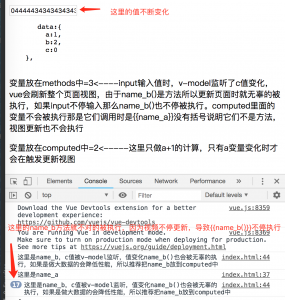
https://cn.vuejs.org/v2/guide/computed.html#%E8%AE%A1%E7%AE%97%E5%B1%9E%E6%80%A7%E7%9A%84-setter
还额外提供一个set属性
computed:{
fullName:{
get: function (){
return this.firstName + ' ' + this.lastName
},
set: function (newValue) {
//一旦this.fullName = '1122'属性有改变就会触发set
this.firstName = newValue
this.lastName = '改了'
}
}
},
表单
案例:test
模板
//需要控制大部分html显示、隐藏的 就把html都放入<template>里面
//v-show 不能用在 <template>上 也不支持 v-else
<template v-if="message"> <h1>Title</h1> <p>Paragraph 1</p> <p>Paragraph 2</p> </template> <p v-else>No</p> 取代v-else的方法: <p v-show="condition">YES</p> <p v-show="!condition">NO</p>
(提示:频繁切换推荐使用v-show,因为v-if每次显示的时候都需要耗性能)
过滤器表达式
过滤器只能放在{{ }} 和 v-bind 中
{{ message | capitalize }} //message的值传入到capitalize函数里面进行过滤处理后在返回
{{ message | filterA | filterB }} //过滤条件可以叠加
{{ message | filterA (‘arg1', arg2) }} //过滤传参数,默认第一个参数是message,‘arg1', arg2分别是第二、第三个参数
<li v-for="(value,index) in scroll_img" :class="value.xx | filterA">
{{index}}
</li>
自定义过滤器
<p>{{name | time_style | add_year}}</p> //name是数据,name数据会经过time_style、add_year的过滤
data:{
name:new Date(), //原始数据
},
filters:{
time_style:function (value) {
console.log(value); //这里的value就是new Date()
return value.getHours()+':'+value.getMinutes()+':'+value.getSeconds()
},
add_year:function (value) {
console.log(value); //这里的value是经过time_style处理过后返回来的值
return "2017-"+value
}
}
条件语句 (显隐)
//v-if是直接删除DOM来控制显隐
<p v-if="greeting">Hello!</p>
<p v-else>No</p>
条件可以这么写
<h1 v-if="yes">Yes!</h1>
<h1 v-if="no">No!</h1>
<h1 v-if="age >= 25">Age: {{ age }}</h1>
<h1 v-if="name.indexOf('jack') >= 0">Name: {{ name }}</h1>
var vm = new Vue({
el: '#app',
data: {
yes: true,
no: false,
age: 28,
name: 'keepfool'
}
})
//v-show根据display: none;来控制显隐
<p v-show="message">YES</p>
<p v-else>No</p>
2.1.0 新增
<div v-if="type === 'A'">
A
</div>
<div v-else-if="type === 'B'">
B
</div>
<div v-else-if="type === 'C'">
C
</div>
<div v-else>
Not A/B/C
</div>
元素属性attr
data: {
text:'text',
value:'值',
url:'http://baidu.com',
a_title:'a连接'
}
<a v-bind:href="url" v-bind:title="a_title">aaa</a>
//<a href="http://baidu.com" title="a连接">aaa</a>
<input v-bind:type="text" v-bind:value="value">
//<input type="text" value="值">
<a v-bind:href="url"></a>
缩写:
<a :href="url"></a>
data(){
msg:'内容'
name:'titlexx',
event:'click'
},
template:`<div :[name]="msg" @[event]="handle"></div>`,
methods:{
handle(){
}
}
效果:
<div titlexx="内容"></div>
class动态添加
在vue中添加class推荐使用v-bind:class来添加
对象方法:
(1)
<div class="static" v-bind:class="{ 'class-a': isA, 'class-b': isB }"></div>
data: {
isA: true,
isB: false
}
结果:<div class="static class-a"></div>
(2)
<div v-bind:class="classObject"></div>
data: {
classObject: {
'class-a': true,
'class-b': false
}
}
数组方法:
<div v-bind:class="[classA, classB]">
data: {
classA: 'class-a',
classB: 'class-b'
}
<div class="class-a class-b"></div>
数组和对象
<div v-bind:class="[{'active':a},iserror]"> fasdfasdf </div>
data:{
a:true,
iserror:'name_class'
},
结果:<div class="active name_class"> fasdfasdf </div>
另一种表达式
<div v-bind:class="[classA, { classB: isB, classC: isC }]">
三元表达式
<div v-bind:class="[classA, isB ? classB : '']">
如果遇到负责判断推荐使用计算属性,如:
<input type="text" v-model="name" :class="class_array">
var app=new Vue({
el:"#app",
data:{
a:true,
b:false
},
computed:{
class_array:function () {
return {
class_1: this.a && !this.b
}
}
}
});
css样式
(推荐)对象方法:
<div v-bind:style="styleObject"></div>
data: {
styleObject: {
color: 'red',
fontSize: '13px'
}
}
数组方法:
<div v-bind:style="[styleObjectA, styleObjectB]">fff</div>
data: {
styleObjectA:{color:'red'},
styleObjectB:{fontSize:'13px'},
}
常规:
<img alt="" :style="'background:url('+val.cover_picture+') no-repeat center;border:0'">
结果都是:<div style="color: red; font-size: 13px;">fff</div>
都类似要学会举一反三
DOM事件
v-on:input 缩写 @input
<input type="text" @input="fn"> //fn写需要的逻辑判断
类似于jquery写法
$('.tx').bind('input propertychange', function() {
document.title=$(this).val();
});
图片监听事件
<img :src="item.iconUrl" @error="errorImgfn" >
methods: {
errorImgfn(e){
e.target.src=require('@/assets/imgs/dbsx.png')
},
}
或者
<img :src="item.iconUrl" :onerror="errorImg" >
data () {
return {
errorImg: 'this.src="' + require('@/assets/imgs/dbsx.png') + '"'
};
},
同样也有@onload=""
案例:
methods:{
click:function(e){
console.log(this);
}
}
<button v-on:click="click($event)">点</button>
缩写:<button @click="click($event)">点</button>
解除事件绑定:
vue不像jquery有unbind和off,但是可以利用一些小技巧去实现,例如:
<div id="app">
<button @click="status && fn($event)">xxx</button>
<p><button @click="bian">change</button></p>
</div>
new Vue({
el:'#app',
data:{
status:true
},
methods:{
fn:function (e) {
console.log(e)
},
bian:function () {
this.status=false;
}
}
});
//通过改变status变量去实现
常用:
@focus //input 获取焦点 @blur // 失去焦点
touch事件
长按,点击事件
<div @touchstart="gotouchstart()" @touchmove="gotouchmove" @touchend="gotouchend()"></div>
methods:{
gotouchstart(img){
touch_time=new Date()/1000; //记录手指放在屏幕上的时间
temp_time=0;
run_fn=null;
clearTimeout(run_fn);
run_fn= setTimeout(function () {
Tools.dialog.strHtml('<div><img style="display: block;width: 70%;" src="'+img+'"> </div>');
},800);
},
//手释放,如果在800毫秒内就释放,则取消长按事件,此时可以执行onclick应该执行的事件
gotouchend(num){
var self=this;
if( Math.ceil( ((new Date()/1000)-touch_time)*100 )/100>0.8 ){
// console.log('长按');
}else{
clearTimeout(run_fn);
self.gokill(num);
}
},
//如果手指有移动,则取消所有事件,此时说明用户只是要移动而不是长按
gotouchmove(){
clearTimeout(run_fn);
},
}
指令修饰符
<a v-bind:href.literal="url" v-bind:title="a_title">aaa</a> 直接显示 <a href="url" title="a连接">aaa</a> //href直接显示属性名 禁止默认行为 <button v-on:submit.prevent="onSubmit"></button> //相当于加了event.preventDefault() <a @click.stop=“"> </a> //阻止事件冒泡 <div @click.self></div> //只有该元素触发,不包括子元素
1,事件修饰符
.stop //阻止事件冒泡 .prevent //阻止默认行为,例如点击a会自动跳页面,点击<input type=“submit”>会刷新提交数据 .capture //一般事件都是在冒泡时候被执行的,addEventListener(‘click’,fn,true) ,添加此修饰符相当于改成了true,默认是false .self //例如当父元素绑定了click,父元素里面又有一个子元素,当点击了子元素时候,其实同时也点击了父元素因为父元素包裹着子元素嘛,click触发。当给父元素添加.self时,在点击子元素时候,就不会出发click了。也有阻止冒泡的效果,相当于e.currentTarget .once //2.1.4 新增,只触发一次事件 .native // v-on:click.native,这样触发的就是js原生的click事件了而不是vue封装好的事件 <a v-on:click.stop="doThis"></a> //阻止默认行为 <a v-on:click.stop.prevent="doThat"></a> //同时阻止默认行为和事件冒泡 <form v-on:submit.prevent></form> //只添加修饰符 ,不添加其他参数
2,键盘修饰符
<!-- 同上 --> <input v-on:keyup.enter=“fn”> //当input获取焦点时候,按回车就会触发fn事件,对外调用就是 vm.fn()事件 <!-- 缩写语法 --> <input @keyup.enter=“fn"> 或者 <input @keyup.13="fn" type="text”> 按键组合 <input @keyup.ctrl.67="fn" type="text”> //获取input焦点后同时按住ctrl+c 就能触发fn函数 键盘别名 enter tab delete esc space up down left right ctrl alt shift meta (mac是command,win是windows) 自定义别名 Vue.config.keyCodes.huiche=13
3,数据同步修饰符
lazy //效果都是同步,但是只有在input失去焦点时候才同步数据 number //将字符串的数字转化为数字类型,如果是NaN直接显示此数据,例如是abc123,说明是NaN,那就直接显示abc123 trim //自动去掉 首尾空格 举例: <input v-model.lazy="msg"> <input v-model.number="msg"> <input v-model.trim="msg">
属性监听$watch
https://cn.vuejs.org/v2/api/#watch
var vm = new Vue({
el:'#app',
data:{
str:'你好',
arr:[],
obj:{
a:''
}
},
watch:{
str:function(new_value,old_value){
},
'obj.a':{
handler: function (new_value,old_value) { /* ... */ }
}
//或者
'obj':{
handler: function (new_value,old_value) { new_value.a },
deep: true, //深度监听
immediate: true //true时,默认执行一次handler函数
}
}
});
或者
https://cn.vuejs.org/v2/api/#vm-watch
vm.$watch('str', function (new_value,old_value) { //属性值发生改变就会触发
},{
deep: true
});
//注意如果直接监听整个对象arr或者obj,old_value返回来的值跟new_value是一样的
input监听
两种方法
1,v-on:input
<input type="text" v-on:input ="inputFunc($event)">
methods:{
inputFunc:function (e) {
document.title=e.target.value;
},
}
2,watch
<input type="number" :value="buy_num" v-model="buy_num">
data:{
buy_num:0
},
watch:{
buy_num:function(){
console.log(this.buy_num);
}
}
循环、遍历
数据:
data:{
array:['陈陈',20,'男'],
obj:{
xx1:'数字1',
xx2:'数字2',
xx3:'数字3'
},
}
数组:
<ul>
<li v-for="(value,index) in array">
索引:{{index}}----值:{{value}}
</li>
</ul>

对象:
<ul>
<li v-for="(value,key,index) in obj">
属性名:{{key}}---
值是:{{value}}---
索引是{{index}}
</li>
</ul>

复合数据:
data:{
scroll_img:[
{img_name:1},
{img_name:2},
{img_name:3},
{img_name:4}
]
},
methods:{
remove_li:function (index) {
this.scroll_img.splice(index,1)
}
}
对象和数组:
<ul>
<li :class="'xx-'+index" :title="value.img_name" v-for="(value,index) in scroll_img">
值是:{{value.img_name}}---
索引是{{index}} ----
<button @click="remove_li(index)">删除该项</button>
</li>
</ul>
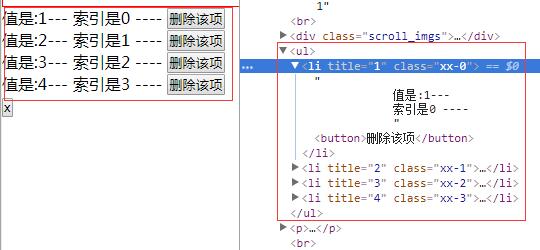
v-for互嵌
data:{
scroll_img:[
{img_name1:1},
{img_name2:2},
{img_name3:3},
{img_name4:4},
]
}
<ul>
<li v-for="(value,index) in scroll_img">
索引:{{index}}---
<span v-for=" (val,key,index) in value"> 属性:{{key}} </span>---
<span v-for=" (val,key,index) in value"> 值:{{val}} </span>
</li>
</ul>

v-for 筛选、过滤
在遍历的同时不希望有些数据显示出来
1,//v-bind:class方法,给不需要显示的数据添加指定class名隐藏或者添加test自定义过滤方法
<li v-for="(value,index) in scroll_img" :class="!!value.xx?'gg':'mm' | test">
索引:{{index}}---
</li>
2,//v-show方法,跟v-bind:class效果类似仅仅是隐藏,dom还是存在的
3,//v-if,直接把不希望显示的数据删除
<li v-for="(value,index) in scroll_img" v-if="!value=='xx'"> //遍历出来的value值如果等于xx字符串就不显示
索引:{{index}}---
</li>
4,通过计算属性在过滤后才把值带入到v-for中遍历
v-for排序:升序、降序
如果希望遍历的值根据某个字段降序或者升序,要先通过计算属性排列好才带入到v-for循环中
:key重新渲染
案例:
默认情况使用v-for渲染列表时,在每个input输入内容,如下
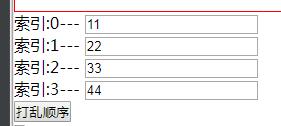
在点击“打乱顺序”,reverse(),视图上并没有发生任何变化,其实dom结构已经发生了变化,如图:

所以需要强制在更新一次排序视图才能同步更新,给遍历input的dom结构添加一个:key=”index”属性,index必须是唯一不能重复,添加之后在点击“打乱顺序”,

如果在使用v-for遍历数据时,如果数据发生了变化但是视图没变可以尝试使用:key来解决。
https://cythilya.github.io/2017/04/27/vue-list-rendering/
生命周期
vue的一系列执行过程,其实都通过以下的钩子(回调函数)捕获到,同时也可以通过钩子在我们需要的某时刻添加我们需要的功能。
(1)第一次刷新页面加载时都会触发到以下钩子:
beforeCreate //常用,添加类似loding效果 create //常用,在数据显示到视图时,在额外添加数据到vm.$data中 beforeMount mounted //常用,有时需要获取dom,或者把接口的数据插入到dom中
(2)数据发生改变时:
beforeUpdate updated //常用,数据发生改变后回调
(3) 销毁(就是停止数据的双向绑定效果)vm.$destroy()
beforeDestroy destroyed //常用,销毁后回调
虽然生命周期经历过这几个步骤,但是常用的也就那么几个。
组件封装(重点)
自己一个经典案例:《vue树节点创建以及增删改》
作用就是可以重复性的利用代码,例如选项卡组件可以在同一个页面下 多次使用。
组件分:全局 和 局部
1,全局
var myComponent = Vue.extend({
template: '<div>This is my first component!</div>’ //这个是子组件,组件必须要有一个容器div包裹着才行
})
// 2.注册组件,并指定组件的标签,组件的HTML标签为<my-component>
Vue.component('my-component', myComponent) <---全局组件声明方法
或者
Vue.component('my-component',{
template: '<div>This is my first component!</div>’ //这个是子组件,组件必须要有一个容器div包裹着才行
})
//全局组件声明一定要写在new Vue实例对象的前面不然就出错
new Vue({
el: '#app'
});
调用: <div id="app"> <!-- 3. #app是Vue实例挂载的元素,应该在挂载元素范围内使用组件--> <my-component></my-component> //调用组件,放在哪个vm容器下就在哪个vm显示,这个是父组件 </div>
2,局部
new Vue({
el: '#app',
components: {
'my-component' : {
template:'<div> <button @click="fn">按钮1</button> <p>{{value}}</p> </div>'
}
}
});
或者
var myComponent = Vue.extend({
template: '<div>This is my first component!</div>'
})
new Vue({
el: '#app',
components: {
// 2. 将myComponent组件注册到容器#app实例下,也就只有此vm容器内部可以使用其他的容器不行
'my-component' : myComponent
}
});
调用: <div id="app"> <!-- 3. my-component只能在#app下使用--> <my-component></my-component> </div>
以上发现一个问题如果在组件复杂的时候template需要很多html就很麻烦且不好写,
可以利用<script type=”text/x-template” id=”page”>
案例:
<script type="text/x-template" id="page">
<ul>
<li></li>
</ul>
</script>
Vue.component("page",{ template:"#page"})
或者
template:'<div>\
<h2>我是子组件的标题</h2>\
<slot>\
只有在没有要分发的内容时才会显示。\
</slot>\
</div>'
特殊dom结构 使用is
例如table的结构都是固定的,要基于这样固定结构模板来写组件要这么做
<table>
<tbody is="my-component"></tbody> //这里的tbody会被模版替代
</table>
Vue.component('my-component',{
template:'<tbody><tr><td>123</td></tr></tbody>'
});
效果:
<table><tbody><tr><td>123</td></tr></tbody></table>
类似的还有ul ol select
*注意:不推荐使用table表格里面嵌套vue代码会报错,尤其是ie10以上浏览器。推荐使用div+css去模拟table表格
.vam { display: table; border-collapse:separate;border-spacing: 5px; } //table
.vam>div { display: table-row; } //tr
.vam>div>div { display: table-cell; vertical-align: middle; } //td
<div class="vam">
<div>
<div> </div>
</div>
</div>
组件继承
//组件继承使用场景,可以把多组件使用比较多的方法独立封装成一个公共组件,其他组件在去调用,避免写重复代码。
<div id="root">
</div>
var a={
template:`<div>123---{{xxx}}</div>`
}
var x=Vue.extend(a);
new x({
el:'#root',
data:{
xxx:'aaa'
}
});
//父组件
var a={
template:`<div>123</div>`,
mounted(){
console.log('a父亲');
}
}
//子组件
var b={
extends:a, //子继承父
template:`<div>456</div>`, //子模板覆盖父模板
mounted(){
console.log('b子');
this.$parent.$options.name //打印出实例化对象的name属性值
}
}
实例化方法1:
var c=Vue.extend(b); //组件b插入到Vue对象中
new c({
el:'#root'
});
实例化方法2: //推荐使用这种写法
new Vue({
name:'root',
el:'#root',
components:{
diycomponent:b
},
template:'<diycomponent></diycomponent>'
});
//结果
a父亲
b子
parent案例:
var a={
template:`
<div>
<div>{{haha}}---{{baba}}</div>
123</div>
`,
props:['baba']
}
var b={
extends:a, //b组件继承a组件
data:function () {
return {
haha:'给父组件传参'
}
}
}
var xx=new Vue({
name:'xx',
data:{
a1:'11',
b2:'22'
}
});
new Vue({
parent:xx, //继承xx的new Vue对象
el:'#root',
components:{
com:b //引入组件b
},
template:'<com :baba="this.$parent.a1"></com>', //将组件渲染出来
mounted:function () {
console.log( this.$parent.a1 ); //获取到指定父元素的值,可以获取不推荐去修改
}
});
组件传参 (重点)
要向组件中的template模板传值,只能靠组件中的data和props
prop 是单向绑定的:当父组件的属性变化时,将传导给子组件,但是不会反过来。
//以下是子组件
Vue.component('todo-item', { //组件要放在最前面不能放在new Vue后面
template: ‘<li v-show=“num">This is a todo{{num}}------{{value1}}-----{{value2}}</li>’, //子组件
data:function () { //传递参数,这里要使用function
return {num:0} //返回的也必须是对象
},
props:['value1','value2’] //父组件要传值给子组件就必须在props里面声明变量
})
//以上是子组件
var vm = new Vue({
el: '#app’,
data:{
parentMsg:’字符串'
}
});
<div id="app">
<ol>
//如果要获取到vue实例对象里面的数据就要使用v-bind,以下parentMsg就是vue实例对象中data的数据
<todo-item value1="参数1" v-bind:value2="parentMsg"></todo-item> //<--这个是父组件
</ol>
</div>
其实就是v-model和参数结合
<input type="text" v-model="parentMsg"> <my-dir v-bind:value1="parentMsg"></my-dir> //value1是子组件里面的props里的属性,parentMsg是vue实例化对象中data里的数据
3,传递数据类型
用v-bind 和 不用的区别
<my-dir value1="1"></my-dir> //这时候传递的是字符串类型 <my-dir v-bind:value1="1"></my-dir> //这时候传递的是数字类型 <my-dir value1="[1,2]"></my-dir> //传递给模板的数据类型仅仅是字符串 <my-dir :value1="[1,2]"></my-dir> //传给模板的数据类型是数组
4,参数验证
限制父组件参数传入的类型,或者自定义传入参数的验证方法 。这些主要组件给别人用时做的限制。
例如:
props:{
value1: {
type: Number,
default: 100
},
value2:Number,
value3:[String,Number],
value4:{
type:Boolean,
required:true
},
value5:{
type:Array,
default:function(){
return [];
}
},
value6:{
validator:function(value){ //自定义验证,value6=“11” 传入的值必须大于10
return value>10
}
}
}
除了以上类型还有 Object 、Function
案例:
<my-dir value1=“1″></my-dir> //这样限制了value1传入的类型,必须是数字类型,如果组件没设置value1属性,那么默认出入值为100
还有更多请参考api
5,子组件传参数给父组件
父组件可以通过props传参数给子组件,子组件可以通过以下方法做到,就必须使用自定义事件
$on(eventName) 监听事件 //适用在不同组件之间传参使用
$emit(eventName) 触发事件 //适用子组件传参给父组件。例如$emit(‘click’,data)该方法都写子组件中 ,这里的click是父组件中,data是子组件要传给父组件的数据
$once只有触发一次
直接看例子:
<my-component @on_jia="get_num" v-on:on_jian="get_num"></my-component>
<p>这里的str是vue实例化对象里面的数据:{{str}}</p>
Vue.component('my-component',{
template:'<div><button @click="jia(num)">+</button>-----<button @click="jian(num)">-</button></div>',
data:function () {
return {num:0}
},
methods:{
jia:function (value) {
value=value+1;
this.num=value;
this.$emit('on_jia',this.num);
},
jian:function (value) {
value=value-1;
this.num=value;
this.$emit('on_jian',this.num);
}
}
});
var vm=new Vue({
el:'#app',
data:{
str:0
},
methods:{
get_num:function (value) {
this.str=value;
}
}
});
最终效果:把组件里面的参数值传给了实例化对象
过程:
1,子组件里面通过 this.$emit(自定义方法,参数) 自定义一个方法,并把参数带进去。
2,父组件通过v-on监听,子组件自定义的方法,并触发一个回调事件get_num,get_num负责把子组件参数获取过来。(中介作用)
3,在vue实例化对象中,在methods里面同样声明一个get_num并获取到,父组件传过来的数据。
$on使用
<div id="xx">
<div @click="haha()">s</div>
</div>
<script>
// click事件->haha->$emit->$on->diyclick->geth
new Vue({
el:'#xx',
data(){
return{
a1:'初始数据'
}
},
created(){
//$on可以为一个自定义事件定义多个方法,遇到复杂的逻辑可以这样处理不需要都写在一起。
//一个事件多个方法按上到下顺序执行
this.$on('diyclick',this.geth);
this.$on('diyclick',this.geth_1);
//也可以在同一个函数上自定义多个自定义事件,打印看看this._events
//this.$on(['diyclick_1','diyclick_2'],this.geth);
},
methods:{
geth(e){
console.log(this.a1,e); //this.a1 是$on自己的数据,e是顺带了$emit的数据
},
geth_1(e){
console.log('这里是geth_1数据',e);
},
haha(){
this.$emit('diyclick','$emit自己的数据');
}
}
})
</script>
6,不同组件之间的传参(非父子关系) 跨组件传参
描述:两个组件,分别在不同的vue实例中,实现相互之间的传递参数,借助一个第三个空的vue实例和$emit、$on
//创建/src/eventbus.js
import Vue from 'vue'
export default new Vue()
//子组件1
<button @click="fn">1</button>
import Eventbus from '@/eventbus'
export default {
name: "test1",
methods:{
fn(){
Eventbus.$emit('send',{a:1}) //发送参数
}
}
}
//子组件2
import Eventbus from '@/eventbus'
export default {
name: "test2",
mounted() {
Eventbus.$on('send',(e)=>{
console.log(e) //接收到{a:1}
})
}
}
7,组件数据共享
其实只要在全局环境中 声明一个对象,在组件的data里面引用即可
var obj={num:0}
data:function(){
return obj
}
8,父组件传值给子组件里的计算属性
<my-component :value="1"></my-component> //父组件 传一个 数字类型 值为1 给子组件
Vue.component('my-component',{
template:'<div>{{xx}}</div>’, //计算属性的结果给 模板
props:['value'],
computed:{
xx:function () {
return this.value+2; //获取父组件的参数 并 参数计算后在把结果传给模板
}
}
});
9,子组件直接获取,组件所在的vue实例对象里面的data数据
<div id="app"> <xx></xx> </div>
Vue.component('xx',{
template:'<a> </a>',
methods:{
fn:function(){
this.$parent.num //num是实例对象里面的数据
}
}
});
new Vue({
el:'#app',
data:{
num:0
}
});
父组件直接获取子组件数据是用this.$children ,会遍历出所有的子组件
10, new Vue实例对象直接获取子组件的data数据,可以在父组件上用ref=””,如下案例:
<div id="app"> <xx ref="comA"></xx> <a @click="fn"></a> </div> //给组件取名字,方便快速定位
Vue.component('xx',{
template:'<a> </a>',
data:function(){
return {num:0}
}
});
new Vue({
el:'#app',
methods:{
fn:function(){
this.$refs.comA.num //num是子组件的数据
}
}
});
*注意如果在父组件里的子节点使用ref是获取到dom元素,如:
<xx ref="comA"> <span ref="comB">111</span> </xx> this.$refs.comA.num //num是子组件的数据,打印0 this.$refs.comB //打印 dom元素 <span ref="comB">111</span>
11,孙子获取爷爷数据,provide / inject
//孙子组件
var onecomponent={
template:`<div> 345 </div>`,
inject:[
'yeye',
//'data'
],
mounted(){
console.log( this.yeye.baba );
//console.log( data.baba );
}
}
//儿子组件
var component_temp={
template:`
<div> <slot baba="baba22"></slot> <haha></haha> </div>
`,
data(){
return{
xx:'11'
}
},
components:{
haha:onecomponent //引入孙子组件
},
props:['value1']
}
new Vue({
el:'#root',
provide:function(){
//这里代码,防止低版本的vue,孙子在获取爷爷数据时候,没有双向数据绑定效果而写的
// var data={}
// var _this=this;
// Object.defineProperty(data,'baba',{
// get:function () {
// return _this.baba
// },
// enumerable:true
// })
return{
yeye:this,
// data:data
}
},
components:{
com:component_temp
},
template:'<com ref="x"> <p slot-scope="diy">{{diy.baba}}</p> </com>', //爷爷组件
data:{
baba:'baba11' //孙子要获取爷爷的数据
}
});
父子组件方法调用
vue 父调用子方法
子:
mounted(){
this.$on('bridge',(val)=>{
this.childAction(val);
});
///此时通过$on进行监听中间桥接函数bridge对目的方法childAction进行触发
},
methods:{
childAction(val='hello world'){
console.log(val) //得到爸爸传来的数据
}
}
父:
<Category ref="category"></Category>
<el-button @click="addcate()">修改分类</el-button>
addcate(){
this.$refs.category.$emit('bridge','这里是要给儿子的数据');
}
子调用父亲
(1)通过this.$parent.event来调用父组件的方法
父组件
methods: {
fatherMethod() {
console.log('测试');
}
}
子组件
mounted() {
this.$parent.fatherMethod();
}
(2)子组件里用$emit
父组件
<child @fatherMethod="fatherMethod"></child>
methods: {
fatherMethod() {
console.log('测试');
}
}
子组件
this.$emit('fatherMethod'); //调用
(3)父组件把方法传入子组件中,在子组件里直接调用这个方法
父组件
<child :fatherMethod="fatherMethod"></child>
methods: {
fatherMethod() {
console.log('测试');
}
}
子组件
props: {
fatherMethod: {
type: Function,
default: null
}
},
mounted(){
if (this.fatherMethod) {
this.fatherMethod();
}
}
动态组件 (类似选项卡)
需要特殊<component v-bind:is=”str”></component>
其实也就是多个组件项目切换 显示
<div id="app">
<a @click="fn('comA')"></a>
<a @click="fn('comB')"></a>
<component v-bind:is="str"></component> //str显示哪个组件名就显示那个组件
</div>
var vm=new Vue({
el:'#app',
data:{
str:'comA'
},
methods:{
fn:function(value){
this.str=value;
}
},
components:{
'comA':{
template:'<a>1</a>'
},
'comB':{
template:'<a>2</a>'
}
}
});
<keep-alive> <component :is="currentView"> <!-- 非活动组件将被缓存! --> </component> </keep-alive>
异步组件
有些组件可能要从别的地方获取数据后才显示出来,这时候肯定考虑异步
<div id="app">
<com ref="haha"></com>
<button @click="fn">点我</button>
<p>{{str}}<p>
</div>
var vm=new Vue({
el:'#app',
data:{
str:''
},
methods:{
fn:function(value){
this.str=this.$refs.haha.num;
}
},
components:{
'com':function (a,b) {
$.ajax({
url:'http://localhost/test_duble_data.html',
success:function () {
a({
template:'<div>xx</div>',
data:function(){
return {num:'子组件传来的数据'}
}
});
}
});
}
}
});
强制更新,实现数据双向绑定效果
html:
<div id="root">
<div>{{text}}--{{obj.a}}</div> //正常来说如果要在模板中使用obj.a,那么在vue实例中就要预先声明obj中的a变量即使是空值也好。
</div>
var app=new Vue({
el:'#root',
// template:'<div>{{text}}--{{obj.a}}</div>',
data:{
text:0,
obj:{} //但是在obj中并没有预先声明a变量,就算在后面临时赋值obj.a=xxx,在模板中调用也不会有值显示。
}
});
var i=0;
setInterval(()=>{
i++;
app.obj.a=i; //临时给a赋值
app.$forceUpdate(); //如果要为临时设置的也实现双向绑定就要强制更新组件。(不太推荐)
//如果没有临时预设属性,又不想使用强制更新,可以使用app.$set(app.obj,'a',i),作用是临时补上a属性到data中
},1000)
DOM回调函数
按理来说我们使用vue是不需要操作dom的,但是偏偏可能我们在做一些动画效果时,就是要需要等dom加载完成后才去执行
<div id="app">
<div id="haha" v-if="num">数据</div>
<button @click="fn">点我</button>
</div>
var vm=new Vue({
el:'#app',
data:{
num:false
},
methods:{
fn:function(){
this.num=true;
this.$nextTick(function(){ //等待#app容器下的dom加载完成后才执行以下代码
$('#haha').text();
});
}
}
});
slot内容分发 (插槽)
把这个理解为父组件往子组件传值的另一种方法就行。
或者理解为,在父组件里面写的html想要在子组件渲染出来就需要到slot
//在父组件的<my-component></my-component>标签里面加内容
<div id="app">
<my-component> //这个是父组件,以下内包裹的就是要传给子组件的内容
<p slot="header">头部1</p>
<p slot="header">头部2</p>
<p>主体内容1</p>
<p>主体内容2</p>
<p slot="foot">底部1</p>
</my-component>
</div>
<script>
//要显示出父组件加的内容就需要到slot标签
Vue.component('my-component',{
template:'<div> ' +
'<slot name="header"></slot> ' +
'<slot></slot> ' +
'<slot name="foot"></slot> ' +
'<slot name="foot2">父组件没传值就默认显示我</slot> ' +
'</div>'
});
new Vue({
el:'#app'
});
</script>
//渲染效果
<div id="app">
<div>
<p>头部1</p>
<p>头部2</p>
<p>主体内容1</p>
<p>主体内容2</p>
<p>底部1</p>
父组件没传值就默认显示我
</div>
</div>
1,父组件my-component包裹着内容就是要传给子组件的
2,子组件要接收父组件传来的值就要使用<slot></slot>
3, 子组件的<slot name=”xx”>使用name就只能指定接收父组件的<dom slot=”xx”></dom>
父组件可以使用多次<dom slot=”xx”></dom>,子组件也可以接收多个,只要一一对应
4,如果子组件有<slot name=”xx”>设置默认值</slot>,而父组件没有传值来,子组件可以显示默认值
5,只要子组件没有为slot设置name的,父组件的其他内容就默认替换
slot传参 (作用域插槽)
slot结合template使用,子组件传参给父组件,在子组件的slot标签上自定义参数,父组件接收参数时使用scope=””
<my-component>
<template slot="xx" scope="xxx">
<p>123</p>
<p>{{xxx.msg0}}</p>
<p>{{xxx.msg1}}</p>
</template>
</my-component>
<script>
Vue.component('my-component',{
template:'<div> <slot name="xx" :msg1="str" msg0="内容123"></slot> </div>',
data:function () {
return {str:'子组件内容'}
}
});
new Vue({
el:'#app'
});
</script>
//渲染效果
<div id="app">
<div>
<p>123</p>
<p>内容123</p>
<p>子组件内容</p>
</div>
</div>
如果slot没有结合使用<template>时,子组件传参给父组件时,父组件接收参数要使用slot-scope=””
//子组件
template:`
<div> <slot baba="baba22"></slot> </div>
`
//父组件
template:'<com> <p slot-scope="diy">{{diy.baba}}</p> </com>', //父组件接收参数要用slot-scope
$slots
可以利用$slots来获取到父组件传来的slot具名,例如可以获取到父组件传来的dom元素
<my-component>
<p id="nimei" slot="xx">xxx</p>
</my-component>
Vue.component('my-component',{
template:'<div> <slot name="xx" :msg1="str" msg0="内容123"></slot> </div>',
data:function () {
return {str:'子组件内容'}
},
mounted:function () {
document.title=(this.$slots.xx)[0].elm.id //获取到父传来的slot="xx"的dom元素,也就是id="nimei"的p元素
}
});
内联模板
之前介绍slot,在父组件包裹里面写数据就默认相当于参数要传给子组件,
我们也可以不在子组件里的template里面写div,可以直接把父组件里面的
数据当做模板。
<div id="app">
<my-component inline-template> //inline-template告诉父组件,里面内容是当成模板使用,而不是当成slot内容分发给子组件
<div> //跟子组件的template一样写模版最外层同样也要包裹着一个div容器不然没效果
<p>父组件里面的内容就相当于模板了</p>
<p>{{msg}}</p>
<p>{{message}}</p>
<p>{{aa}}</p> //这里优先使用子组件的数据
</div>
</my-component>
</div>
<script>
Vue.component('my-component',{
data:function () {
return {msg:'子组件',aa:'子组件的aa'}
}
});
new Vue({
el:'#app',
data:{
message:'父组件',
aa:'父组件的aa'
}
});
</script>
动态生成vue实例
vue实例都是我们最开始使用new Vue()来实现了,但有时候我们也需要动态是生成。
<div id="app">
<button @click="fn()">动态挂载vue对象</button>
<div id="app2">
</div>
</div>
<script>
var myvue=Vue.extend({
template:'<div><input type="text" v-model="haha"><p>{{haha}}</p></div>',
data:function () {
return {haha:''}
}
})
new Vue({
el:'#app',
data:{
message:'父组件',
aa:'父组件的aa'
},
methods:{
fn:function () {
new myvue().$mount('#app2');
}
}
});
</script>
自定义指令
<div id="app">
<input type="text" v-focus="{haha:'笑哈哈'}">
</div>
<script>
//以下是全局
Vue.directive('focus',{
bind:{},
});
//以下是局部 自定义指令
new Vue({
el:'#app',
directives:{
focus:{
bind:function (el,binding) { //仅仅执行一次,作用就是为绑定的元素,添加初始化值。
el.value=1
el.className='nihao';
el.addEventListener('click',function () {
console.log('绑定');
});
console.log(el); //笑哈哈
el.xx=123; //要想其他钩子函数都能调用到,就把要公用的属性和方法都写在el中
},
inserted:function (el,binding) { //dom加载完成后,就调用
el.focus();
console.log(el.xx); //123
},
update:function (el,binding,vnode,oldVnode) {
},
componentUpdated:function (el,binding,vnode,oldVnode) {
},
unbind:function (el,binding) {
}
}
}
});
</script>
render函数 虚拟dom vue创建html
template:'<div ref="x"></div>' //template里面的html,最终还是靠render函数显示到页面上的
等价
render(createElement){
return createElement('div',{
ref:'x'
});
},
具体更多用法参考:https://cn.vuejs.org/v2/guide/render-function.html
**注意:能用template创建html就尽量用,否则使用render创建html会增加难度。
使用场景是:当模板出现重复性比较高时可以考虑使用,例如:
<script type="text/x-template" id="xx">
<div>
<h1 v-if="show">
<a></a>
</h1>
<h2 v-if="show">
<a></a>
</h2>
<h3 v-if="show">
<a></a>
</h3>
<h4 v-if="show">
<a></a>
</h4>
</div>
</script>
如果出现类似以上的重复性出现的dom就考虑使用虚拟dom进行遍历了。
对比学习效率会比较高
template:'\
<div id="ele"> \
:class="show:show" \
@click="fn">内容</div>'
比较
render:function(createElement){
return createElement(
'div',
{
class:{'show':this.show}
attrs:{id:'ele'},
on:{click:this.fn}
},
'内容'
)
}
可读性明显template比render好,所以要看情况使用虚拟dom不然会带来不便。
上面的案例都知道传进来的createElement参数才是最关键的,而这个参数是一个函数,
函数里面又有3个参数
createElement(
{string|object|function}, //必选 (根据逻辑判断生成不同的dom元素标签)
{object}, //可选 (数据填充,第二个参数玩法很多)
{string|array} //可选 (子节点)
)